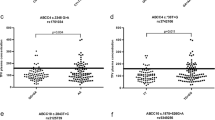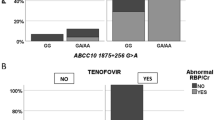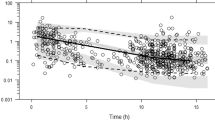Abstract
Higher exposure to tenofovir (TFV) increases the risk for kidney function decline, but the impact of genetic factors on TFV exposure is largely unknown. We investigated whether single-nucleotide polymorphisms (SNPs, n=211) in 12 genes are potentially involved in TFV exposure. Participants (n=91) from the Women’s Interagency HIV Study, underwent a 24 h intensive pharmacokinetic sampling of TFV after witnessed dose and TFV area under the time–concentration curves (AUCs) were calculated for each participant. SNPs were assayed using a combination of array genotyping and Sanger sequencing. Linear regression models were applied to logarithmically transformed AUC. Those SNPs that met an a priori threshold of P<0.001 were considered statistically associated with TFV AUC. ABCG2 SNP rs2231142 was associated with TFV AUC with rare allele carriers displaying 1.51-fold increase in TFV AUC (95% confidence interval: 1.26, 1.81; P=1.7 × 10−5). We present evidence of a moderately strong effect of the rs2231142 SNP in ABCG2 on a 24 h TFV AUC.
This is a preview of subscription content, access via your institution
Access options
Subscribe to this journal
Receive 6 print issues and online access
$259.00 per year
only $43.17 per issue
Buy this article
- Purchase on Springer Link
- Instant access to full article PDF
Prices may be subject to local taxes which are calculated during checkout

Similar content being viewed by others
References
Umeh OC, Currier JS . Sex differences in pharmacokinetics and toxicity of antiretroviral therapy. Expert Opin Drug Metab Toxicol 2006; 2: 273–283.
Baxi SM, Scherzer R, Greenblatt RM, Minkoff H, Sharma A, Cohen M et al. Higher tenofovir exposure is associated with longitudinal declines in kidney function in women living with HIV. AIDS 2016; 30: 609–618.
Arab-Alameddine M, Decosterd LA, Buclin T, Telenti A, Csajka C . Antiretroviral drug toxicity in relation to pharmacokinetics, metabolic profile and pharmacogenetics. Expert Opin Drug Metab Toxicol 2011; 7: 609–622.
Burger D, Hugen P, Reiss P, Gyssens I, Schneider M, Kroon F et al. Therapeutic drug monitoring of nelfinavir and indinavir in treatment-naive HIV-1-infected individuals. AIDS 2003; 17: 1157–1165.
Collin F, Chene G, Retout S, Peytavin G, Salmon D, Bouvet E et al. Indinavir trough concentration as a determinant of early nephrolithiasis in HIV-1-infected adults. Ther Drug Monit 2007; 29: 164–170.
Ezinga M, Wetzels JF, Bosch ME, van der Ven AJ, Burger DM . Long-term treatment with tenofovir: prevalence of kidney tubular dysfunction and its association with tenofovir plasma concentration. Antivir Ther 2014; 19: 765–771.
Gutierrez F, Navarro A, Padilla S, Anton R, Masia M, Borras J et al. Prediction of neuropsychiatric adverse events associated with long-term efavirenz therapy, using plasma drug level monitoring. Clin Infect Dis 2005; 41: 1648–1653.
Kappelhoff BS, van Leth F, Robinson PA, MacGregor TR, Baraldi E, Montella F et al. Are adverse events of nevirapine and efavirenz related to plasma concentrations? Antivir Ther 2005; 10: 489–498.
Marzolini C, Telenti A, Decosterd LA, Greub G, Biollaz J, Buclin T . Efavirenz plasma levels can predict treatment failure and central nervous system side effects in HIV-1-infected patients. AIDS 2001; 15: 71–75.
Wang J, Kou H, Fu Q, Han Y, Qiu Z, Zuo L et al. Nevirapine plasma concentrations are associated with virologic response and hepatotoxicity in Chinese patients with HIV infection. PLoS ONE 2011; 6: e26739.
WHO Guideline on When to Start Antiretroviral Therapy and on Pre-Exposure Prophylaxis for HIV. WHO: Geneva, Switzerland, 2015.
WHO Consolidated Guidelines on the Use of Antiretroviral Drugs for Treating and Preventing HIV Infection: Recommendations for a Public Health Approach. WHO: Geneva, Switzerland, 2013.
Scherzer REM, Li Y, Choi AI, Deeks SG, Grunfeld C, Shlipak MG . Association of tenofovir exposure with kidney disease risk in HIV infection. AIDS 2012; 26: 867–875.
Baxi SM, Greenblatt RM, Bacchetti P, Scherzer R, Minkoff H, Huang Y et al. Common clinical conditions - age, low BMI, ritonavir use, mild renal impairment - affect tenofovir pharmacokinetics in a large cohort of HIV-infected women. AIDS 2014; 28: 59–66.
Gervasoni C, Meraviglia P, Landonio S, Baldelli S, Fucile S, Castagnoli L et al. Low body weight in females is a risk factor for increased tenofovir exposure and drug-related adverse events. PLoS ONE 2013; 8: e80242.
Hill A, Khoo S, Back D, Pozniak A, Boffito M . Should the dose of tenofovir be reduced to 200-250 mg/day, when combined with protease inhibitors? J Int AIDS Soc 2014; 17: 19583.
Kearney BP, Mathias A, Mittan A, Sayre J, Ebrahimi R, Cheng AK . Pharmacokinetics and safety of tenofovir disoproxil fumarate on coadministration with lopinavir/ritonavir. J Acquir Immune Defic Syndr 2006; 43: 278–283.
Kiser JJ AC, Anderson PL, King TM, Carten ML, Fletcher CV . Clinical and genetic determinants of intracellular tenofovir diphosphate concentrations in HIV-infected patients. J Acquir Immune Defic Syndr 2008; 47: 298–303.
Kiser JJ CM, Aquilante CL, Anderson PL, Wolfe P, King TM, Delahunty T et al. The effect of lopinavir/ritonavir on the renal clearance of tenofovir in HIV-infected patients. Clin Pharmacol Ther 2008; 83: 265–272.
Nishijima T, Komatsu H, Gatanaga H, Aoki T, Watanabe K, Kinai E et al. Impact of small body weight on tenofovir-associated renal dysfunction in HIV-infected patients: a retrospective cohort study of Japanese patients. PLoS ONE 2011; 6: e22661.
Poizot-Martin I, Solas C, Allemand J, Obry-Roguet V, Pradel V, Bregigeon S et al. Renal impairment in patients receiving a tenofovir-cART regimen: impact of tenofovir trough concentration. J Acquir Immune Defic Syndr 2013; 62: 375–380.
Rodriguez-Novoa S, Labarga P, D'Avolio A, Barreiro P, Albalate M, Vispo E et al. Impairment in kidney tubular function in patients receiving tenofovir is associated with higher tenofovir plasma concentrations. AIDS 2010; 24: 1064–1066.
Szczech LA . Renal dysfunction and tenofovir toxicity in HIV-infected patients. Top HIV Med 2008; 16: 122–126.
Izzedine HHJ, Villard E, Goyenvalle C, Dominguez S, Ghosn J, Valantin MA et al. Association between ABCC2 gene haplotypes and tenofovir-induced proximal tubulopathy. J Infect Dis 2006; 194: 1481–1491.
Rodríguez-Nóvoa SLP, Soriano V, Egan D, Albalater M, Morello J, Cuenca L et al. Predictors of kidney tubular dysfunction in HIV-infected patients treated with tenofovir: a pharmacogenetic study. Clin Infect Dis 2009; 48: e108–e116.
Rodriguez-Novoa SLP, Soriano V . Pharmacogenetics of tenofovir treatment. Pharmacogenomics 2009; 10: 1675–1685.
Elens LTD, Panin N, Courtoy P, Lison D, Demoulin JB, Haufroid V . Functional defect caused by the 4544G>A SNP in ABCC2: potential impact for drug cellular disposition. Pharmacogenet Genomics 2011; 21: 884–893.
Pushpakom SP LN, Rodríguez-Nóvoa S, Labarga P, Soriano V, Albalater M, Hopper-Borge E et al. Genetic variants of ABCC10, a novel tenofovir transporter, are associated with kidney tubular dysfunction. J Infect Dis 2011; 204: 145–153.
Kohler JJ HS, Green E, Abuin A, Ludaway T, Russ R, Santoianni R et al. Tenofovir renal proximal tubular toxicity is regulated by OAT1 and MRP4 transporters. Lab Invest 2011; 91: 852–858.
Nishijima T KH, Higasa K, Takano M, Tsuchiya K, Hayashida T, Oka S et al. Single nucleotide polymorphisms in ABCC2 associate with tenofovir-induced kidney tubular dysfunction in Japanese patients with HIV-1 infection: a pharmacogeneticstudy. Clin Infect Dis 2012; 55: 1558–1567.
Barkan SE, Melnick SL, Preston-Martin S, Weber K, Kalish LA, Miotti P et al. The Women's Interagency HIV Study. WIHS Collaborative Study Group. Epidemiology 1998; 9: 117–125.
Bacon MC, von Wyl V, Alden C, Sharp G, Robison E, Hessol N et al. The Women's Interagency HIV Study: an observational cohort brings clinical sciences to the bench. Clin Diagn Lab Immunol 2005; 12: 1013–1019.
Gandhi M, Benet LZ, Bacchetti P, Kalinowski A, Anastos K, Wolfe AR et al. Nonnucleoside reverse transcriptase inhibitor pharmacokinetics in a large unselected cohort of HIV-infected women. J Acquir Immune Defic Syndr 2009; 50: 482–491.
Gandhi M, Greenblatt RM, Bacchetti P, Jin C, Huang Y, Anastos K et al. A single-nucleotide polymorphism in CYP2B6 leads to >3-fold increases in efavirenz concentrations in plasma and hair among HIV-infected women. J Infect Dis 2012; 206: 1453–1461.
Delahunty T, Bushman L, Robbins B, Fletcher CV . The simultaneous assay of tenofovir and emtricitabine in plasma using LC/MS/MS and isotopically labeled internal standards. J Chromatogr B Anal Technol Biomed Life Sci 2009; 877: 1907–1914.
Halder I, Shriver M, Thomas M, Fernandez JR, Frudakis T . A panel of ancestry informative markers for estimating individual biogeographical ancestry and admixture from four continents: utility and applications. Hum Mutat 2008; 29: 648–658.
Edlund CK, Lee WH, Li D, Van Den Berg DJ, Conti DV . Snagger: a user-friendly program for incorporating additional information for tagSNP selection. BMC Bioinformatics 2008; 9: 1–13.
Haas DW, Gebretsadik T, Mayo G, Menon UN, Acosta EP, Shintani A et al. Associations between CYP2B6 polymorphisms and pharmacokinetics after a single dose of nevirapine or efavirenz in African americans. J Infect Dis 2009; 199: 872–880.
Yeh KC, Kwan KC . A comparison of numerical integrating algorithms by trapezoidal, Lagrange, and spline approximation. J Pharmacokinet Biopharm 1978; 6: 79–98.
Kearney BP, Yale K, Shah J, Zhong L, Flaherty JF . Pharmacokinetics and dosing recommendations of tenofovir disoproxil fumarate in hepatic or renal impairment. Clin Pharmacokinet 2006; 45: 1115–1124.
Kiser JJ, Fletcher CV, Flynn PM, Cunningham CK, Wilson CM, Kapogiannis BG et al. Pharmacokinetics of antiretroviral regimens containing tenofovir disoproxil fumarate and atazanavir-ritonavir in adolescents and young adults with human immunodeficiency virus infection. Antimicrob Agents Chemother 2008; 52: 631–637.
Le MP, Landman R, Koulla-Shiro S, Charpentier C, Sow PS, Diallo MB et al. Tenofovir plasma concentrations related to estimated glomerular filtration rate changes in first-line regimens in African HIV-infected patients: ANRS 12115 DAYANA substudy. J Antimicrob Chemother 2015; 70: 1517–1521.
Calza LTF, Tedeschi S, Piergentili B, Manfredi R, Colangeli V, Viale P . Tenofovir-induced renal toxicity in 324 HIV-infected, antiretroviral-naïve patients. Scand J Infect Dis 2011; 43: 656–660.
Dahlin A, Wittwer M, de la Cruz M, Woo JM, Bam R, Scharen-Guivel V et al. A pharmacogenetic candidate gene study of tenofovir-associated Fanconi syndrome. Pharmacogenet Genomics 2015; 25: 82–92.
Likanonsakul S, Suntisuklappon B, Nitiyanontakij R, Prasithsirikul W, Nakayama EE, Shioda T et al. A Single-Nucleotide Polymorphism in ABCC4 Is Associated with Tenofovir-Related Beta2-Microglobulinuria in Thai Patients with HIV-1 Infection. PLoS ONE 2016; 11: e0147724.
Manosuthi W, Sukasem C, Thongyen S, Nilkamhang S, Sungkanuparph S . ABCC2*1C and plasma tenofovir concentration are correlated to decreased glomerular filtration rate in patients receiving a tenofovir-containing antiretroviral regimen. J Antimicrob Chemother 2014; 69: 2195–2201.
Giacomet V, Cattaneo D, Vigano A, Nannini P, Manfredini V, Ramponi G et al. Tenofovir-induced renal tubular dysfunction in vertically HIV-infected patients associated with polymorphisms in ABCC2, ABCC4 and ABCC10 genes. Pediatr Infect Dis J 2013; 32: e403–e405.
Stark K, Reinhard W, Grassl M, Erdmann J, Schunkert H, Illig T et al. Common polymorphisms influencing serum uric acid levels contribute to susceptibility to gout, but not to coronary artery disease. PLoS ONE 2009; 4: e7729.
Woodward OM, Kottgen A, Coresh J, Boerwinkle E, Guggino WB, Kottgen M . Identification of a urate transporter, ABCG2, with a common functional polymorphism causing gout. Proc Natl Acad Sci USA 2009; 106: 10338–10342.
Dehghan A, Kottgen A, Yang Q, Hwang SJ, Kao WL, Rivadeneira F et al. Association of three genetic loci with uric acid concentration and risk of gout: a genome-wide association study. Lancet 2008; 372: 1953–1961.
Kolz M, Johnson T, Sanna S, Teumer A, Vitart V, Perola M et al. Meta-analysis of 28,141 individuals identifies common variants within five new loci that influence uric acid concentrations. PLoS Genet 2009; 5: e1000504.
Zhang L, Spencer KL, Voruganti VS, Jorgensen NW, Fornage M, Best LG et al. Association of functional polymorphism rs2231142 (Q141K) in the ABCG2 gene with serum uric acid and gout in 4 US populations: the PAGE Study. Am J Epidemiol 2013; 177: 923–932.
Polgar O, Robey RW, Bates SE . ABCG2: structure, function and role in drug response. Expert Opin Drug Metab Toxicol 2008; 4: 1–15.
Neumanova Z, Cerveny L, Ceckova M, Staud F . Interactions of tenofovir and tenofovir disoproxil fumarate with drug efflux transporters ABCB1, ABCG2, and ABCC2; role in transport across the placenta. AIDS 2014; 28: 9–17.
Nettles RE, Kieffer TL, Parsons T, Johnson J, Cofrancesco J Jr, Gallant JE et al. Marked intraindividual variability in antiretroviral concentrations may limit the utility of therapeutic drug monitoring. Clin Infect Dis 2006; 42: 1189–1196.
Acknowledgements
We thank the Women's Interagency HIV Study (WIHS) participants who contributed data to this study. Data were collected by the WIHS Collaborative Study Group with centers (Principal Investigators at the time of data collection) at New York City/Bronx Consortium (KA); Brooklyn, New York (Howard Minkoff, MD); Washington DC, Metropolitan Consortium (MAY); The Connie Wofsy Study Consortium of Northern California (RMG, Phyllis Tien and BEA); Los Angeles County/Southern California Consortium (Alexandra Levine, MD); Chicago Consortium (MC); and Data Coordinating Center (SJG). The contents of this publication are solely the responsibility of the authors and do not necessarily represent the official views of the US National Institutes of Health. WIHS (Principal Investigators): UAB-MS WIHS (Michael Saag, Mirjam-Colette Kempf and Deborah Konkle-Parker), U01-AI-103401; Atlanta WIHS (Ighovwerha Ofotokun and Gina Wingood), U01-AI-103408; Bronx WIHS (KA), U01-AI-035004; Brooklyn WIHS (Howard Minkoff and Deborah Gustafson), U01-AI-031834; Chicago WIHS (MC and Audrey French), U01-AI-034993; Metropolitan Washington WIHS (MAY and Seble Kassaye), U01-AI-034994; Miami WIHS (Margaret Fischl and Lisa Metsch), U01-AI-103397; UNC WIHS (Adaora Adimora), U01-AI-103390; Connie Wofsy Women’s HIV Study, Northern California (RMG, BEA and Phyllis Tien), U01-AI-034989; WIHS Data Management and Analysis Center (SJG and Elizabeth Golub), U01-AI-042590; Southern California WIHS (Joel Milam), U01-HD-032632 (WIHS I – WIHS IV). The WIHS is funded primarily by the National Institute of Allergy and Infectious Diseases (NIAID), with additional co-funding from the Eunice Kennedy Shriver National Institute of Child Health and Human Development (NICHD), the National Cancer Institute (NCI), the National Institute on Drug Abuse (NIDA) and the National Institute on Mental Health (NIMH). Targeted supplemental funding for specific projects is also provided by the National Institute of Dental and Craniofacial Research (NIDCR), the National Institute on Alcohol Abuse and Alcoholism (NIAAA), the National Institute on Deafness and other Communication Disorders (NIDCD) and the NIH Office of Research on Women’s Health. WIHS data collection is also supported by UL1-TR000004 (UCSF CTSA) and UL1-TR000454 (Atlanta CTSA). SMB is supported by the UCSF Traineeship in AIDS Prevention Studies (US National Institutes of Health (NIH) T32 MH-19105). This research was also supported by a grant from the National Institutes of Health, University of California, San Francisco-Gladstone Institute of Virology and Immunology Center for AIDS Research, P30-AI027763.
Author information
Authors and Affiliations
Consortia
Corresponding author
Ethics declarations
Competing interests
The authors declare no conflict of interest.
Additional information
Results from this paper were presented, in part, at the 22nd Conference on Retroviruses and Opportunistic Infections in Seattle, WA, USA, from 23–26 February 2015.
Supplementary Information accompanies the paper on the The Pharmacogenomics Journal website
Supplementary information
PowerPoint slides
Rights and permissions
About this article
Cite this article
Baxi, S., Greenblatt, R., Bacchetti, P. et al. Evaluating the association of single-nucleotide polymorphisms with tenofovir exposure in a diverse prospective cohort of women living with HIV. Pharmacogenomics J 18, 245–250 (2018). https://doi.org/10.1038/tpj.2017.3
Received:
Revised:
Accepted:
Published:
Issue Date:
DOI: https://doi.org/10.1038/tpj.2017.3



